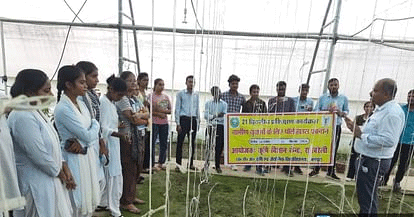Polyhouse farming, a modern agricultural method, is rapidly gaining traction as an effective way to boost crop production by controlling the environment within a protective structure. Unlike traditional farming, which leaves crops vulnerable to unpredictable weather, polyhouses provide a shield, allowing farmers to regulate temperature, humidity, and light. This method has been especially successful in growing high-demand crops like tomatoes, bell peppers, and flowers, such as gerbera and roses.
Why Polyhouse Farming?
Dr. S.V. Singh, a horticultural scientist at the Krishi Vigyan Kendra (KVK) Dariyapur, highlighted that polyhouse farming addresses the limitations of open-field agriculture. By controlling air, temperature, and humidity, farmers can grow crops throughout the year, regardless of external weather conditions. This creates the perfect environment for cultivating a wide variety of crops that typically struggle with seasonal changes.
In India, polyhouse farming has been promoted through extensive training programs like the 21-day polyhouse management technique training held at KVK Dariyapur. During the program, participants, mostly young farmers, learned about polyhouse construction, crop management, nutrient management, fertigation, and pest control. Dr. Singh also emphasized the importance of site selection for establishing polyhouses, taking into account factors like irrigation, soil structure, pollution levels, labor availability, and geographic location.
Key Benefits of Polyhouse Farming
- Climate Control for Consistent Yield:
Polyhouses maintain a temperature that is 5-10°C cooler than the outside environment, making them ideal for growing sensitive crops like tomatoes and bell peppers. This controlled environment ensures optimal growing conditions year-round, leading to higher yields compared to traditional farming methods. - Water Efficiency:
Polyhouse farming reduces water usage through precision irrigation systems, such as drip irrigation, that ensure crops get the exact amount of water they need without wastage. This is particularly important in regions facing water scarcity. - Higher Crop Quality and Quantity:
Studies show that polyhouse farming can double or even triple crop yields. For example, in the case of tomatoes and bell peppers, farmers have reported a significant increase in production. Additionally, the quality of produce is higher, with fewer defects, resulting in better market prices. - Pest and Disease Control:
Since polyhouses are enclosed, the spread of pests and diseases is minimized. Farmers can use integrated pest management techniques that further reduce the need for chemical pesticides, aligning with the global trend toward organic and sustainable farming practices.
Global Adoption and Future of Polyhouse Farming
Polyhouse technology is currently being used in more than 50 countries, including India, Israel, and the Netherlands, where it has proven to be a game-changer in improving agricultural productivity. In India, the adoption of polyhouses has been supported by government initiatives and subsidies aimed at helping farmers transition to modern farming techniques. According to Dr. R.P.N. Singh, who spoke at the training event’s conclusion, the development of new crop varieties and innovative methods like the Direct Seeded Rice (DSR) technique are further enhancing the scope of polyhouse farming in the country.
Polyhouse farming is an innovative and efficient way to increase agricultural productivity by allowing farmers to control key environmental factors. With the ability to grow crops year-round and minimize losses from pests and adverse weather, polyhouses provide a reliable, high-yield option for modern farmers. As more farmers receive training in polyhouse management, the agricultural sector stands to benefit from increased profitability and sustainable farming practices.












